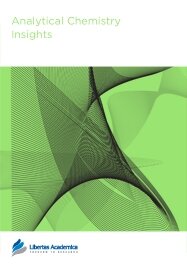

Publication Date: 07 Nov 2011
Type: Original Research
Journal: Analytical Chemistry Insights
Citation: Analytical Chemistry Insights 2011:6 67-78
doi: 10.4137/ACI.S8090

Three simple spectrophotometric and atomic absorption spectrometric methods are developed and validated for the determination of moxifloxacin HCl in pure form and in pharmaceutical formulations. Method (A) is a kinetic method based on the oxidation of moxifloxacin HCl by Fe3+ ion in the presence of 1,10 o-phenanthroline (o-phen). Method (B) describes spectrophotometric procedures for determination of moxifloxacin HCl based on its ability to reduce Fe (III) to Fe (II), which was rapidly converted to the corresponding stable coloured complex after reacting with 2,2' bipyridyl (bipy). The formation of the tris-complex formed in both methods (A) and (B) were carefully studied and their absorbance were measured at 510 and 520 nm respectively. Method (C) is based on the formation of ion- pair associated between the drug and bismuth (III) tetraiodide in acidic medium to form orange—red ion- pair associates. This associate can be quantitatively determined by three different procedures. The formed precipitate is either filtered off, dissolved in acetone and quantified spectrophotometrically at 462 nm (Procedure 1), or decomposed by hydrochloric acid, and the bismuth content is determined by direct atomic absorption spectrometric (Procedure 2). Also the residual unreacted metal complex in the filtrate is determined through its metal content using indirect atomic absorption spectrometric technique (procedure 3). All the proposed methods were validated according to the International Conference on Harmonization (ICH) guidelines, the three proposed methods permit the determination of moxifloxacin HCl in the range of (0.8–6, 0.8–4) for methods A and B, (16–96, 16–96 and 16–72) for procedures 1–3 in method C. The limits of detection and quantitation were calculated, the precision of the methods were satisfactory; the values of relative standard deviations did not exceed 2%. The proposed methods were successfully applied to determine the drug in its pharmaceutical formulations without interference from the common excipients. The results obtained by the proposed methods were comparable with those obtained by the reference method.
PDF (680.65 KB PDF FORMAT)
RIS citation (ENDNOTE, REFERENCE MANAGER, PROCITE, REFWORKS)
BibTex citation (BIBDESK, LATEX)
XML
PMC HTML


I have published more than thirty research papers in internationally reputed high impact factor journals including Libertas Academica publications, Proteomics Insights and Analytical Chemistry Insights. I have no hesitation in saying that Proteomics Insights is highly efficient for its rapid and high quality review process and keeping the authors informed at each stage of the publication process. I recommend this journal for students, teachers and research workers who wish to publish their work. ...
Facebook Google+ Twitter
Pinterest Tumblr YouTube